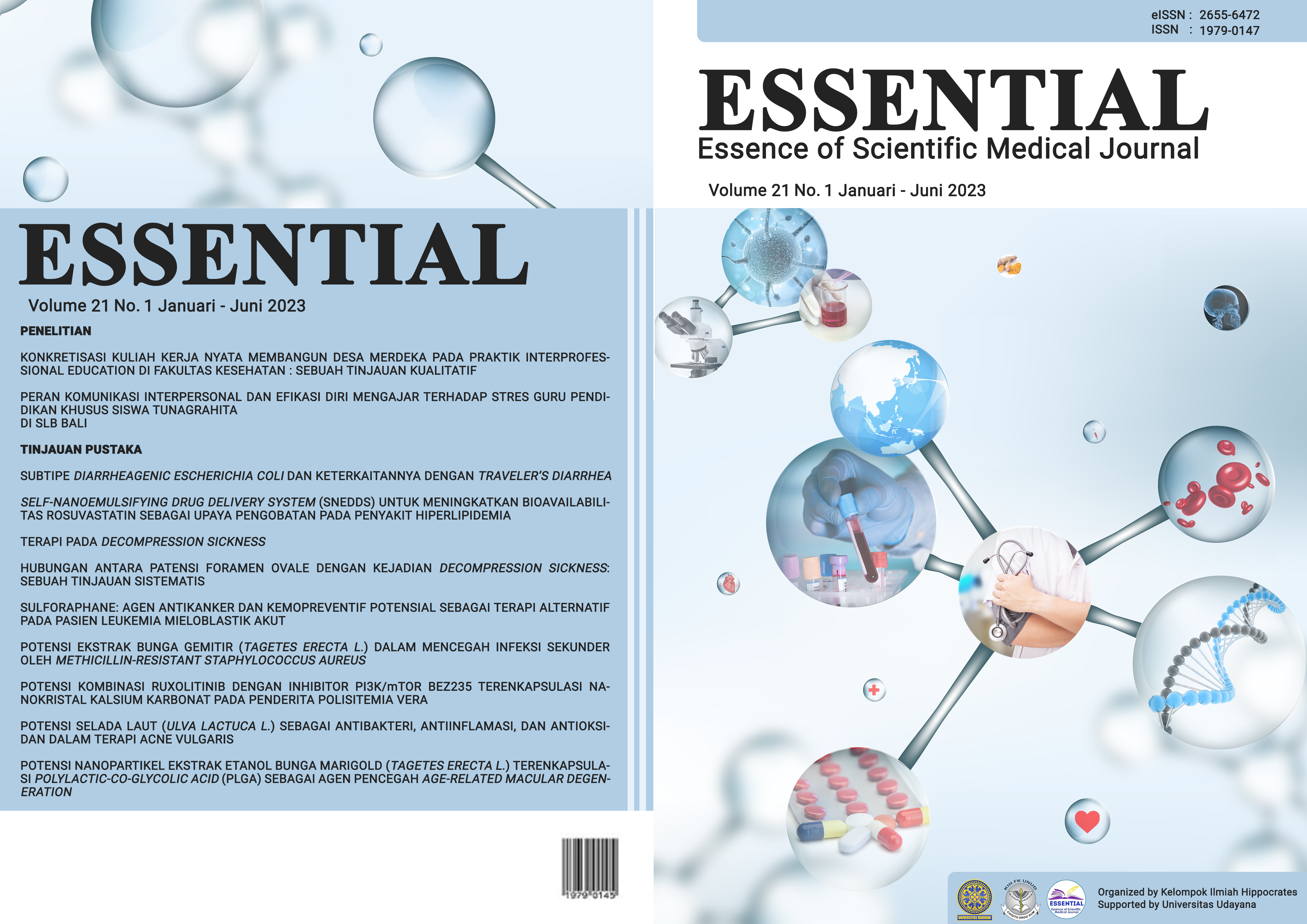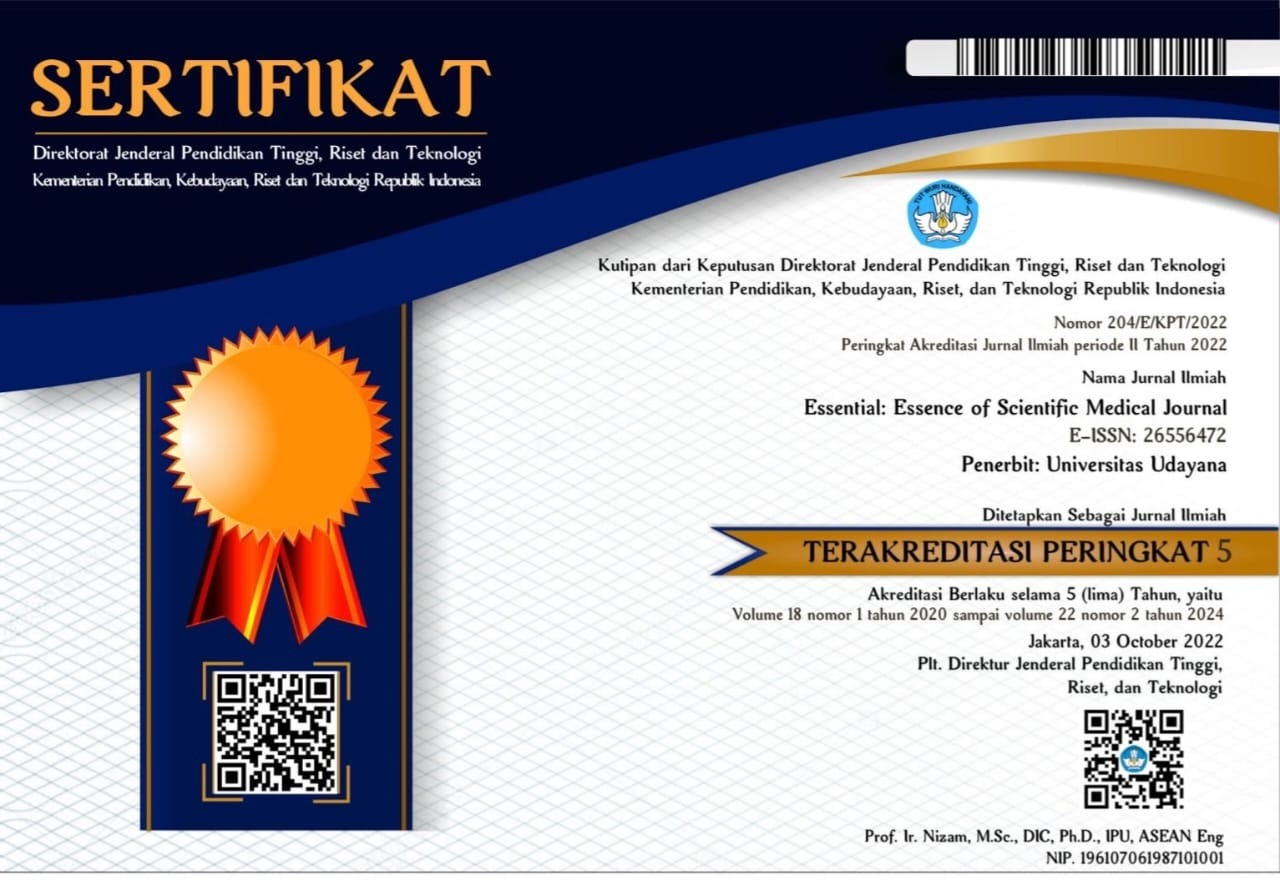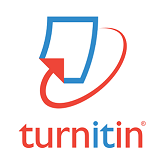SELF-NANOEMULSIFYING DRUG DELIVERY SYSTEM (SNEDDS) UNTUK MENINGKATKAN BIOAVAILABILITAS ROSUVASTATIN SEBAGAI UPAYA PENGOBATAN PADA PENYAKIT HIPERLIPIDEMIA
Abstract
ABSTRAK
Pendahuluan: Hiperlipidemia merupakan keadaan dimana kadar kolesterol atau low-density lipoprotein cholesterol (LDL-C) dalam darah diatas kadar normal. Rosuvastatin merupakan obat jenis statin yang memiliki efektivitas paling tinggi dalam menurunkan LDL-C sehingga dapat mengobati hiperlipidemia dengan baik. Pemberian rosuvastatin dalam dosis yang kecil memiliki kemampuan untuk mengurangi kadar LDL-C dengan lebih baik dibandingkan dengan obat statin lainnya yang membutuhkan dosis dalam jumlah lebih banyak. Penggunaan rosuvastatin dengan pemberian secara oral belum maksimal dalam pengobatan hiperlipidemia karena bioavailabilitas dari rosuvastatin sangat rendah yaitu sekitar 20%. Oleh karena itu, dibutuhkan suatu sistem penghantaran obat yang dapat meningkatkan penyerapan rosuvastatin.
Pembahasan: SNEDDS merupakan modifikasi baru pada sistem penghantaran obat yang dikategorikan sebagai lipid based drug delivery system (LBDDS) berupa campuran isotropik yang terdiri dari komponen minyak, surfaktan dan kosolven atau kosurfaktan. SNEDDS akan meningkatkan kelarutan obat dalam saluran pencernaan dengan membentuk partikel-partikel yang sangat kecil yaitu <200 nm melalui nanoemulsi dan meningkatkan luas permukaan antara fase air dan minyak. Rosuvastatin dalam bentuk SNEDDS dapat meningkatkan kelarutan dan bioavailabilitas obat dengan memperbaiki profil farmakokinetika obat.
Simpulan: Rosuvastatin dalam bentuk SNEDDS layak untuk ditinjau lebih lanjut karena efektif dalam menyebabkan perubahan yang sangat signifikan terhadap bioavailabilitas rosuvastatin yang rendah, yaitu dari bioavailabilitas 20% dapat ditingkatkan hingga >80% dengan pemberian SNEDDS.
Kata Kunci: Bioavailabilitas, hiperlipidemia, rosuvastatin, SNEDDS
Downloads
References
2. Akbar A. Pengaruh Pemberian Ekstrak Daun Kersen (Mutingia Calabura L.) TERHADAP Kadar Malondialdehid Darah Pada mencit putih (mus musculus) Jantan Yang Diinduksi diet tinggi lemak [Internet]. UMM Institutional Repository. 2017 [cited 2022Nov25]. Available from: https://eprints.umm.ac.id/41601/
3. Santosa, A. P., Trimurtini, I., & Hasan, K. (2018). Efek Anti Hiperlipidemik Ekstrak Etanol Daging Buah Semangka Merah (Citrullus Lanatus) Terhadap Kadar Low Density Lipoprotein Pada Tikus Jantan Galur Wistar (Rattus Norvegicus). JIMKI: Jurnal Ilmiah Mahasiswa Kedokteran Indonesia, 6(2), 41-48.
4. Buya AB, Beloqui A, Memvanga PB, Préat V. Self-Nano-emulsifying drug-delivery systems: From the development to the current applications and challenges in oral drug delivery. Pharmaceutics. 2020;12(12):1194.
5. Krstić M, Medarević Đ, Đuriš J, Ibrić S. Self-nanoemulsifying drug delivery systems (SNEDDS) and self-microemulsifying drug delivery systems (SMEDDS) as lipid nanocarriers for improving dissolution rate and bioavailability of poorly soluble drugs. Lipid Nanocarriers for Drug Targeting. 2018;:473–508.
6. Jaiswal M, Dudhe R, Sharma PK. Nanoemulsion: An advanced mode of drug delivery system. 3 Biotech. 2014;5(2):123–7.
7. Priani SE. Pengaruh Pengembangan self-nanoemulsifying drug delivery system TERHADAP DISOLUSI, BIOAVAILABILITAS, Dan Aktivitas Agen antihiperlipidemia. Jurnal Ilmiah Farmasi Farmasyifa. 2022;5(1):101–11.
8. Abo Enin HA. Self-nanoemulsifying drug-delivery system for improved oral bioavailability of rosuvastatin using natural oil antihyperlipidemic. Drug Development and Industrial Pharmacy. 2014;41(7):1047–56.
9. Eriksen MB, Frandsen TF. The impact of patient, intervention, comparison, outcome (PICO) as a search strategy tool on literature search quality: A systematic review. Journal of the Medical Library Association. 2018;106(4).
10. Heryani, R.. Pengaruh ekstrak buah naga merah terhadap profil lipid darah tikus putih hiperlipidemia. Jurnal Ipteks Terapan. 2016. 10 (1), 9-17
11. Gustomi, M. P., & Larasati, R. Ekstrak Rimpang Kunyit Menurunkan Kadar Lemak Darah Pasien Hiperlipidemia (Turmeric (Curcuma Longa Linn) Extract Toward Modification of Blood Lipid Level in Hyperlipidemia Patients). Journals of Ners Community, 2015. 6(1), 1-7.
12. Alfiani, F.. Analisis Perbandingan Hasil Terapi Pasien Hiperlipidemia yang Menggunakan Terapi Statin Antara Dua Kelompok Uji dengan Modifikasi Metode Konseling Di Beberapa Apotek Di| Bandung. Jurnal Ilmu Kesehatan UMC. 2020.9(2).
13. Gitawati, R., & Widowati, L. Penggunaan jamu pada pasien hiperlipidemia berdasarkan data rekam medik, di beberapa fasilitas pelayanan kesehatan di Indonesia. Jurnal Kefarmasian Indonesia, 2015. 41-48.
14. Udayani, N. N. W., Putra, I. M. A. S., & Dewi, N. L. K. A. A. (2021). Informasi Obat Penyakit Degeneratif dan Alternatif Terapinya. COMSERVA: Jurnal Penelitian dan Pengabdian Masyarakat, 1(4), 144-149.
15. Goobie G. Primary hypertriglyceridemia: Pathogenesis and clinical findings: Calgary guide [Internet]. The Calgary Guide to Understanding Disease. 2015 [cited 2022Dec9]. Available from: https://calgaryguide.ucalgary.ca/primary-hypertriglyceridemia-pathogenesis-and-clinical-findings/
16. Hill MF, Bordoni B. Hyperlipidemia - StatPearls - NCBI Bookshelf [Internet]. [cited 2022Dec10]. Available from: https://www.ncbi.nlm.nih.gov/books/NBK559182/
17. Hill MF, Bordoni B. Hyperlipidemia - StatPearls - NCBI Bookshelf [Internet]. [cited 2022Dec10]. Available from: https://www.ncbi.nlm.nih.gov/books/NBK559182/
18. Cortese F, Gesualdo M, Cortese A, Carbonara S, Devito F, Zito A, et al. Rosuvastatin: Beyond the cholesterol-lowering effect. Pharmacological Research. 2016;107:1–18.
19. Bowman CM, Ma F, Mao J, Chen Y. Examination of physiologically‐based pharmacokinetic models of rosuvastatin. CPT: Pharmacometrics & Systems Pharmacology. 2020;10(1):5–17.
20. Luvai A, Mbagaya W, Hall AS, Barth JH. Rosuvastatin: A review of the Pharmacology and clinical effectiveness in cardiovascular disease. Clinical Medicine Insights: Cardiology. 2012;6.
21. Desavathu M. SNEDDS in Shell: A Novel Approach to Enhance the Solubility of Rosuvastatin Calcium. Asian Journal of Pharmaceutics. 2020;14(4).
22. Verma R, Kaushik A, Almeer R, Rahman MH, Abdel-Daim MM, Kaushik D. Improved pharmacodynamic potential of rosuvastatin by self-nanoemulsifying drug delivery system: An in vitro and in vivo evaluation. International Journal of Nanomedicine. 2021;Volume 16:905–24.
23. Khoo KS, Leong HY, Chew KW, Lim J-W, Ling TC, Show PL, et al. Liquid biphasic system: A recent Bioseparation technology. Processes. 2020;8(2):149.
24. Shah MR, Imran M, Ullah S. Nanoemulsions. Lipid-Based Nanocarriers for Drug Delivery and Diagnosis. 2017;:111–37.
25. Singh Y, Meher JG, Raval K, Khan FA, Chaurasia M, Jain NK, et al. Nanoemulsion: Concepts, development and applications in Drug Delivery. Journal of Controlled Release. 2017;252:28–49.
26. Aswathanarayan JB, Vittal RR. Nanoemulsions and their potential applications in food industry. Frontiers in Sustainable Food Systems. 2019;3.
27. Che Marzuki NH, Wahab RA, Abdul Hamid M. An overview of nanoemulsion: Concepts of development and cosmeceutical applications. Biotechnology & Biotechnological Equipment. 2019;33(1):779–97.
28. Rehman FU, Shah KU, Shah SU, Khan IU, Khan GM, Khan A. From nanoemulsions to self-nanoemulsions, with recent advances in self-nanoemulsifying drug delivery systems (SNEDDS). Expert Opinion on Drug Delivery. 2016;14(11):1325–40.
29. Liu B, Hu X. Hollow micro- and nanomaterials: Synthesis and applications. Advanced Nanomaterials for Pollutant Sensing and Environmental Catalysis. 2020;:1–38.
30. Kazi M, Al-Swairi M, Ahmad A, Raish M, Alanazi FK, Badran MM, et al. Evaluation of self-nanoemulsifying drug delivery systems (SNEDDS) for poorly water-soluble talinolol: Preparation, in vitro and in vivo assessment. Frontiers in Pharmacology. 2019;10.
31. Kazi M. Lipid‐based nano‐delivery for oral administration of poorly water soluble drugs (pwsds): Design, optimization and in vitro assessment. Advanced Technology for Delivering Therapeutics. 2017;
32. Sailor GU. Self-nanoemulsifying drug delivery systems (SNEDDS): An innovative approach to improve oral bioavailability. Nanocarriers: Drug Delivery System. 2021;:255–80.
33. Cherniakov I, Domb AJ, Hoffman A. Self-Nano-Emulsifying Drug Delivery Systems: An update of the biopharmaceutical aspects. Expert Opinion on Drug Delivery. 2015;12(7):1121–33.
34. Li L, Hui Zhou C, Ping Xu Z. Self-nanoemulsifying drug-delivery system and solidified self-nanoemulsifying drug-delivery system. Nanocarriers for Drug Delivery. 2019;:421–49.
35. Tripathi CB, Gupta N, Kumar P, Singh AK, Raj V, Parashar P, et al. Ω-3 fatty acid synergized novel Nanoemulsifying system for rosuvastatin delivery: In vitro and in vivo evaluation. AAPS PharmSciTech. 2017;19(3):1205–18.
36. Balakumar K, Raghavan CV, selvan NT, prasad RH, Abdu S. Self nanoemulsifying drug delivery system (SNEDDS) of rosuvastatin calcium: Design, formulation, bioavailability and pharmacokinetic evaluation. Colloids and Surfaces B: Biointerfaces. 2013;112:337–43.
37. Han YR, Lee PI, Pang KS. Finding Tmax and Cmax in multicompartmental models. Drug Metabolism and Disposition. 2018;46(11):1796–804.
38. Giang Thi Thu V, Nghia Thi P, Huyen Thi N, Hung Canh N, Yen Thi Hai T, Tung Bao P, et al. Application of the artificial neural network to optimize the formulation of self-nanoemulsifying drug delivery system containing rosuvastatin. Journal of Applied Pharmaceutical Science. 2020;
39. Beg S, Katare OP, Singh B. Formulation by design approach for development of ultrafine self-nanoemulsifying systems of rosuvastatin calcium containing long-chain lipophiles for Hyperlipidemia Management. Colloids and Surfaces B: Biointerfaces. 2017;159:869–79.


 SUBMISSION
SUBMISSION
















